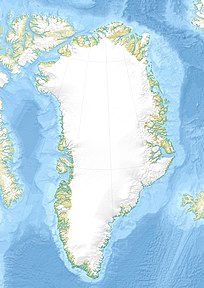Kangerluarsoruseq
| Kangerluarsoruseq | ||
|---|---|---|
| Føroyingahavn (Färingerhafen) Færingehavn (Färingerhafen) Kangerdluarssoruseĸ |
||
| Commune | Kommuneqarfik Sermersooq | |
| District | Nuuk | |
| Geographical location | 63 ° 41 '48 " N , 51 ° 32' 41" W | |
|
|
||
| Residents | 0 (since 2010) |
|
| founding | 1927 | |
| Time zone | UTC-3 | |
Kangerluarsoruseq [ kaˈŋɜɬːuɑˌsːɔʁusɛq ] (according to the old spelling Kangerdluarssoruseĸ ; Danish Færingehavn , Faroese Føroyingahavn ) is a desolate Greenlandic settlement in the Nuuk district in the commune qarfik Sermersooq .
history
founding
A Faroese boat went fishing in Greenland as early as 1906, but systematic Faroese fishing in Greenland did not begin until 1925 , after Britain's expansive trawler fishery in domestic waters forced people to move to the waters around Iceland and Greenland.
Fishing in Greenlandic waters proved to be more productive for the Faroese, albeit more arduous because of the distance - around 2,700 km lies between Kangerluarsoruseq and the Faroe Islands - and the harsh arctic conditions. In the 1920s, Greenland was a closed country. There was a Danish trade monopoly and foreigners were largely forbidden from contact with the Greenlanders - supposedly to keep harmful influences away from them.
In 1925 a three-mile zone was established around Greenland, within which even Danish citizens, including the Faroese, were not allowed to fish. This meant that the fishermen did not have a port in Greenland where they could replenish supplies and carry out repairs after the long journey. This gave rise to increasing pressure from the Faroese on Denmark to give them access to the coast. At the same time, Denmark was accused of failing to protect Faroese fishermen from the UK's fishing expansion. Historian John F. West describes this conflict as the first major dispute between the Faroe Islands, struggling for economic survival, and Denmark.
So in 1926 a port was built on the island of Takisup Qeqertarsua (Ravns Storø), but it was 65 nautical miles from the best fishing grounds. Instead, the Faroese suggested the uninhabited fjord Kangerluarsoruseq , whereupon an agreement was reached and in 1927 the place was moved there. The Faroese named their port Føroyingahavn . The three-mile zone remained in place for the time being until the Faroese were given the right to call at three other ports in 1939: Takisup Qeqertarsua, Toqqusaq near Atammik and Færinger Nordhavn, a port at the Illuerunnerit (Gamle Egedesminde) spot, on the Niels Egede Aasiaat (Egedesminde) founded in 1759 , before the place was moved to its current location four years later.
Upswing and decline
Færingehavn quickly developed from a port of refuge into an international fishing port. In 1933, a lighthouse was built on the Faroese initiative, which made it possible to drive at night and thus extended the working day. The Danish state later took over the operation of this lighthouse. A repair yard was built with a slipway , oil tanks and a salt warehouse. The catch was processed into salt fish , for which a separate warehouse was built. In the Faroe Islands, this salt fish was either sold directly or processed into clipfish beforehand .
In addition, a small hospital and a seaman's home of Føroysk Sjómannsmissión , which was called Lívd (shelter, refuge, bunker) were built. In the following years a number of Faroese women worked here. In 1937, Færingehavn was opened to international fishing by Denmark. The port was expanded further. A larger hospital was built and the old building was turned into a seaman's mission. The 230 meter long pier of Færingehavn has long been considered the longest wooden pier in Europe, although Greenland is a part of North America.
In 1953 the operation of Færingehavn was transferred to the company Nordafar , whereupon another port called Nordafar was built two and a half kilometers further east. The Færinge Oliehavn (also Orsiivik ) oil storage facility , located on the other side of the fjord, dates from 1995. From the 1970s Færingehavn lost its importance due to the Rigsfællesskab and was finally abandoned.
Population development
The population of Kangerluarsoruseq fell steadily from the mid-1980s, and had another strong peak in 1992. The place has been deserted since 2010.

Individual evidence
- ↑ John F. West: Faroe. The Emergence of a Nation . Hurst, London et al. 1972, ISBN 0-8397-2063-7
- ^ Jógvan Arge : Teir tóku land. Føroyingar í Grønlandi , covers and maps by Anker Eli Petersen . Tórshavn: Forlagið Tjarnardeild, 1996-2003. 8 volumes (Faroese, standard work on Faroese-Greenlandic history. The first volume is by Jógvan Arge's father Niels Juel Arge and covers the period up to the Second World War) Homepage
- ↑ Population Kangerluarsoruseq 1977–2018 at bank.stat.gl

